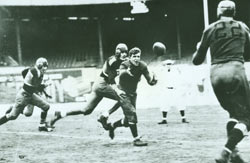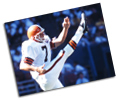Changing the Rules archived
Each Sunday during the NFL season we examine one of the league rules that shape the game as we know it.
Week 4
Helmets
Oct. 2, 2011
The  game of professional football is one of the most physically demanding sports to play. Imagine playing the game on any level without a helmet. That is exactly how some players in the early days of the NFL battled on the green gridiron.
game of professional football is one of the most physically demanding sports to play. Imagine playing the game on any level without a helmet. That is exactly how some players in the early days of the NFL battled on the green gridiron.
The last known player to play without a helmet was Dick Plasman, a two-way lineman for the Chicago Bears. He went helmet-less from 1937 until 1941 when he enlisted in the military to serve during World War II. Plasman played one more year after his service but by then he had to use a helmet. That's because in 1943 the NFL finally got around to making it a requirement. In the 1943 NFL Rule Book, a small note about the requisite was sandwiched in between two separate items about how hard or unyielding knee pads and elbow pads and detachable kicking toes were illegal.
1943 NFL Rule Book Excerpt
 |
| Chicago Bears end Bill Hewitt played all but one season of his Hall of Fame career without a helmet. |
Rule 5, Section 3
All players must wear head protectors
The 2011 NFL Rule Book is far more descriptive regarding the wearing of the helmet (which is now also required during pre-game warm-ups).
Rule 5, Section 4, Article 3 - Helmets, face protectors
(a) Helmet with chinstrap (white only) fastened and facemask attached. Facemasks must not be more than 5/8-inch in diameter and must be made of rounded material; transparent materials are prohibited.
No visible identification of a manufacturer's name or logo on the exterior of a helmet or on any
attachment to a helmet is permitted unless provided for under a commercial arrangement between the League and manufacturer; in no event is identification of any helmet manufacturer permitted on the visible surface of a rear cervical pad. All helmets must carry a small NFL shield logo on the rear lower-left exterior and an approved warning label on the rear lower-right exterior. Both labels will be supplied in quantity by the League office.
Week 3
Instant Replay
Sept. 25, 2011 The 2011 NFL season marks the 13th straight year that there league's current format of Instant Replay has existed. Instant Replay allows each team two challenges per game. A challenge initiates a review of the play in question by the referee at a monitor located on the field. A decision is reversed only when the Referee has indisputable visual evidence to overturn the call. Inside two minutes of each half, all replay challenges are initiated by the Replay Assistant in the booth. In 2011, a change in the Instant Replay format now requires all scoring plays to be reviewed by the Replay Assistant. If there is some doubt about the validity of a score, a challenge is initiated.
The 2011 NFL season marks the 13th straight year that there league's current format of Instant Replay has existed. Instant Replay allows each team two challenges per game. A challenge initiates a review of the play in question by the referee at a monitor located on the field. A decision is reversed only when the Referee has indisputable visual evidence to overturn the call. Inside two minutes of each half, all replay challenges are initiated by the Replay Assistant in the booth. In 2011, a change in the Instant Replay format now requires all scoring plays to be reviewed by the Replay Assistant. If there is some doubt about the validity of a score, a challenge is initiated.Excerpt from the 2011 NFL Rule Book
Section 9 Instant Replay
The League will employ a system of Referee Replay Review to aid officiating for reviewable plays as defined
below. Prior to the two-minute warning of each half, a Coaches' Challenge System will be in effect except
for plays when the on-field ruling results in a score for either team. After the two-minute warning of each
half, throughout any overtime period, and after all scoring plays, a Referee Review will be initiated by a
Replay Official from a Replay Booth comparable to the location of the coaches' booth or Press Box.
From 1986 to 1991, a limited system on Instant Replay was used on a year-by-year basis. That format gave the Replay Official in the booth sole responsible for initiating replay reviews and making the decision to overturn a call on the field.
NFL's history of Instant Replay reviews:
| NFL's history of Instant Replay reviews | |||
| REGULAR SEASON, 1986-1991 | |||
| Year | Games | Plays Reviewed | Reversals |
| 1986 | 224 | 374 | 38 |
| 1987 | 210 | 490 | 57 |
| 1988 | 224 | 537 | 53 |
| 1989 | 224 | 492 | 65 |
| 1990 | 224 | 504 | 73 |
| 1991 | 224 | 570 | 90 |
| TOTAL | 1,330 | 2,967 | 376 |
| REGULAR SEASON, 1999-2010 | ||||
| Year | Games | Total Replay Reviews | Challenges | Reversals |
| 1999 | 248 | 195 | 133 | 57 |
| 2000 | 248 | 247 | 179 | 84 |
| 2001 | 248 | 258 | 191 | 89 |
| 2002 | 256 | 294 | 208 | 94 |
| 2003 | 256 | 255 | 184 | 66 |
| 2004 | 256 | 283 | 233 | 88 |
| 2005 | 256 | 295 | 223 | 92 |
| 2006 | 256 | 311 | 237 | 107 |
| 2007 | 256 | 327 | 250 | 122 |
| 2008 | 256 | 315 | 229 | 117 |
| 2009 | 256 | 328 | 228 | 126 |
| 2010 | 256 | 361 | 252 | 133 |
| TOTAL | 3,048 | 3,469 | 2,547 | 1,175 |

___________________________________________________________________________________________________________________________________________
Week 2
Kickoffs
Sept. 18, 2011
The National Football League drew much attention with its rule change in 2011 that has resulted in the KICKOFF BEING MOVED FORWARD FIVE YARDS to the 35-yard line. The main reason behind the change was to help eliminate injuries which had increased on kickoffs over the years. Furthermore, the kicking team formation was altered so all players other than the kicker must be lined up no more than five yards behind the line. |
| Mel Gray had 3 of the Detroit Lions' league-leading 4 kickoff returns for TDs in 1994. |
Excerpt from the 1920 Official Foot Ball Rules printed in the Spalding's Official Foot Ball Guide
Rule VIII, Section 1. – Position of Players at Kick-Off; Point of Kickoff.
The side having the kick-off shall kick off from its own 40-yard line at a point equidistant from the side lines.
Then in 1974 the league moved the kickoff back to the 35-yard line.
Excerpt from the 1974 NFL Rule Book
Rule 6 – The Free Kick; Section 1 Putting Ball in Play – Article 4
The initial free kick lines during a given free kick shall be as follows (plus or minus any distance they might be moved because of a distance
penalty enforced prior to the kick):
(a) Kickoff – offensive 35
The kickoff remained at that spot for 20 seasons until 1994 when it moved back an additional five yards to the 30-yard line.
Excerpt from the 1994 NFL Rule Book
Rule 6 – The Free Kick; Section 1 Putting Ball in Play – Article 4
The initial free kick lines during a given free kick shall be as follows (plus or minus any distance they might be moved because of a distance
penalty enforced prior to the kick):
For the kicking team:
(a) Kickoff – offensive 30
There has been much fan debate as to what the effects of the current rule will do to the league's return game. Below is a glance of the NFL's kickoff stats before and after each kickoff yard line change.
| Year | Kickoff Yardline | Total Kickoff Returns | Average Returns Per Team | Average Yards Per Return | KOR for TD |
| 1973 | 40 | 1,264 | 48.6 | 22.5 | 10 |
| 1974 | 35 | 1,390 | 53.5 | 22.2 | 4 |
| 1993 | 35 | 1,381 | 49.3 | 19.5 | 4 |
| 1994 | 30 | 1,842 | 65.8 | 21.2 | 16 |
| 2010 | 30 | 2,033 | 63.5 | 22.3 | 23 |
| 2011 | 35 | ? | ? | ? | ? |
Week 1
Two point conversion
Sept. 11, 2011
The 2011 National Football League season marks the 18th year that the league has allowed the option of a TWO-POINT CONVERSION following a touchdown. The rival American Football League had used the two-point conversion during the 1960s but it wasn’t adopted by the NFL until the owners meetingin Orlando, Florida on March 22, 1994.
| 1994 NFL RULE BOOK Excerpt from Rule 11 (Scoring), Section 3 (Try), Article 1 After a touchdown the scoring team is allowed a Try. This Try is an attempt to score one or two additional points during one scrimmage down with the spot of a snap. (b) if a Try results in what would ordinarily be a touchdown by the offense, two points are awarded. If a touchdown is not scored, the Try is over at the end of the play or if there is a change of possession. |
 The first successful NFL two-pointer was scored by a punter. Yes, that’s correct. On Sept. 4, 1994 the Cleveland Browns opened their season on the road against the Cincinnati Bengals at Riverfront Stadium. The Browns scored on an 11-yard touchdown pass from Vinny Testaverde to running back Leroy Hoard in the first quarter. The Browns then lined up as if they were going to kick an extra point. Tom Tupa, the team’s punter and placekick holder took the snap from center and surprised the defense when he ran the ball into the end zone. The two-point play made the score 11-0 in Cleveland’s favor en route to a Browns 28-20 victory.
The first successful NFL two-pointer was scored by a punter. Yes, that’s correct. On Sept. 4, 1994 the Cleveland Browns opened their season on the road against the Cincinnati Bengals at Riverfront Stadium. The Browns scored on an 11-yard touchdown pass from Vinny Testaverde to running back Leroy Hoard in the first quarter. The Browns then lined up as if they were going to kick an extra point. Tom Tupa, the team’s punter and placekick holder took the snap from center and surprised the defense when he ran the ball into the end zone. The two-point play made the score 11-0 in Cleveland’s favor en route to a Browns 28-20 victory.
The 1994 season saw 59 successful conversions on 116 total attempts. As it turns out, those numbers have never been matched as attempts and successful conversions have been on a downward trend since that time. Last season the league combined for a total of 26 successful two-point conversions off of 53 attempts.
| NFL Two-Point Attempt History | ||||||
| Year | Conversion | Attempts | Team High | No. | Att. | |
| 1994 | 59 | 116 | Miami | 6 | 10 | |
| 1995 | 40 | 104 | Arizona | 5 | 6 | |
| 1996 | 44 | 92 | Baltimore/Jacksonville | 5 | 9/6 | |
| 1997 | 47 | 109 | Minnesota | 6 | 8 | |
| 1998 | 41 | 105 | San Francisco | 5 | 9 | |
| 1999 | 31 | 84 | Jacksonville | 4 | 5 | |
| 2000 | 35 | 85 | St. Louis/Detroit | 4 | 9/4 | |
| 2001 | 40 | 90 | multiple teams | 3 | - | |
| 2002 | 47 | 98 | Pittsburgh | 5 | 6 | |
| 2003 | 29 | 66 | Baltimore | 4 | 6 | |
| 2004 | 37 | 76 | Jacksonville/St. Louis | 4 | 4/4 | |
| 2005 | 27 | 53 | Atlanta | 4 | 4 | |
| 2006 | 21 | 41 | Tennessee | 3 | 3 | |
| 2007 | 30 | 61 | New Orleans | 4 | 5 | |
| 2008 | 28 | 68 | multiple teams | 2 | - | |
| 2009 | 24 | 60 | Green Bay | 3 | 5 | |
| 2010 | 26 | 53 | multiple teams | 2 | - | |
| 606 | 1,361 | |||||
Remember When…Week 5 edition – high-five
Jerry Rice put together single game statistics that most receivers would be hard pressed to compile in three or four weeks, some in an entire season.
